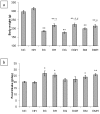Glibenclamide or metformin combined with honey improves glycemic control in streptozotocin-induced diabetic rats
- PMID: 21448302
- PMCID: PMC3065678
- DOI: 10.7150/ijbs.7.244
Glibenclamide or metformin combined with honey improves glycemic control in streptozotocin-induced diabetic rats
Abstract
Diabetes mellitus is associated with deterioration of glycemic control and progressive metabolic derangements. This study investigated the effect of honey as an adjunct to glibenclamide or metformin on glycemic control in streptozotocin-induced diabetic rats. Diabetes was induced in rats by streptozotocin. The diabetic rats were randomized into six groups and administered distilled water, honey, glibenclamide, glibenclamide and honey, metformin or metformin and honey. The animals were treated orally once daily for four weeks. The diabetic control rats showed hypoinsulinemia (0.27 ± 0.01 ng/ml), hyperglycemia (22.4 ± 1.0 mmol/L) and increased fructosamine (360.0 ± 15.6 µmol/L). Honey significantly increased insulin (0.41 ± 0.06 ng/ml), decreased hyperglycemia (12.3 ± 3.1 mmol/L) and fructosamine (304.5 ± 10.1 µmol/L). Although glibenclamide or metformin alone significantly (p < 0.05) reduced hyperglycemia, glibenclamide or metformin combined with honey produced significantly much lower blood glucose (8.8 ± 2.9 or 9.9 ± 3.3 mmol/L, respectively) compared to glibenclamide or metformin alone (13.9 ± 3.4 or 13.2 ± 2.9 mmol/L, respectively). Similarly, glibenclamide or metformin combined with honey produced significantly (p < 0.05) lower fructosamine levels (301.3 ± 19.5 or 285.8 ± 22.6 µmol/L, respectively) whereas glibenclamide or metformin alone did not decrease fructosamine (330.0 ± 29.9 or 314.6 ± 17.9 µmol/L, respectively). Besides, these drugs or their combination with honey increased insulin levels. Glibenclamide or metformin combined with honey also significantly reduced the elevated levels of creatinine, bilirubin, triglycerides, and VLDL cholesterol. These results indicate that combination of glibenclamide or metformin with honey improves glycemic control, and provides additional metabolic benefits, not achieved with either glibenclamide or metformin alone.
Keywords: Diabetes mellitus; fructosamine; glibenclamide; metformin; streptozotocin; tualang honey.
Conflict of interest statement
Conflict of Interest: The authors have declared that no conflict of interest exists.
Figures

References
-
- The Diabetes Control and Complications Trial (DCCT) Research Group. The effect of intensive treatment of diabetes on the development and progression of long term complications in the diabetes control in insulin dependent diabetes mellitus. N Engl J Med. 1993;329:977–986. - PubMed
-
- UK Prospective Diabetes Study (UKPDS) Group. Intensive blood-glucose control with sulphonylureas or insulin compared with conventional treatment and risk of complications in patients with type 2 diabetes. Lancet. 1998;352:837–853. - PubMed
-
- Turner RC, Cull CA, Frighi V. et al. UK Prospective Diabetes Study Group. Glycemic control with diet, sulfonylurea, metformin, or insulin in patients with type 2 diabetes mellitus: progressive requirement for multiple therapies (UKPDS 49) JAMA. 1999;281:2005–2012. - PubMed
-
- UK Prospective Diabetes Study Group. UK Prospective Diabetes Study 16: Overview of 6 years' therapy of type II diabetes: a progressive disease. Diabetes. 1995;44:1249–1258. - PubMed
-
- Yale JF, Valiquett TR, Ghazzi MN. et al. The effect of a thiazolidinedione drug, troglitazone, on glycemia in patients with type 2 diabetes mellitus poorly controlled with sulfonylurea and metformin; a multicenter, randomized, double-blind, placebo-controlled trial. Ann Intern Med. 2001;134:737–745. - PubMed
Publication types
MeSH terms
Substances
LinkOut - more resources
Full Text Sources
Medical

